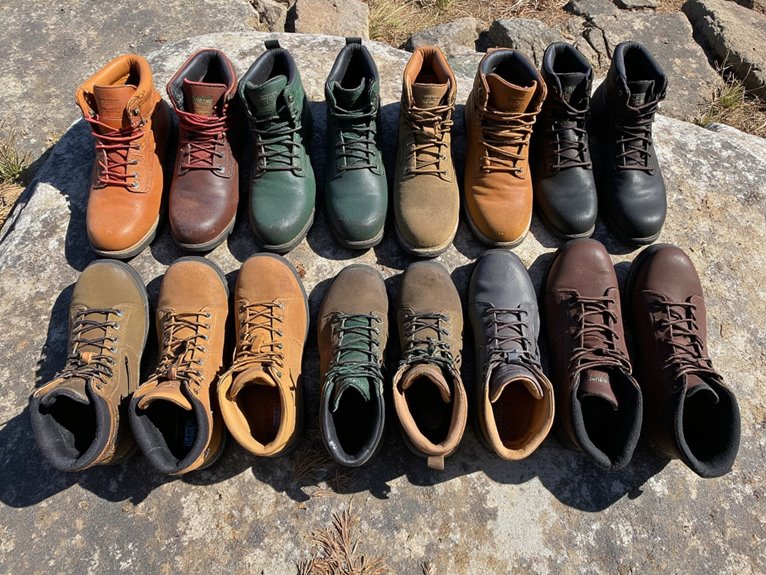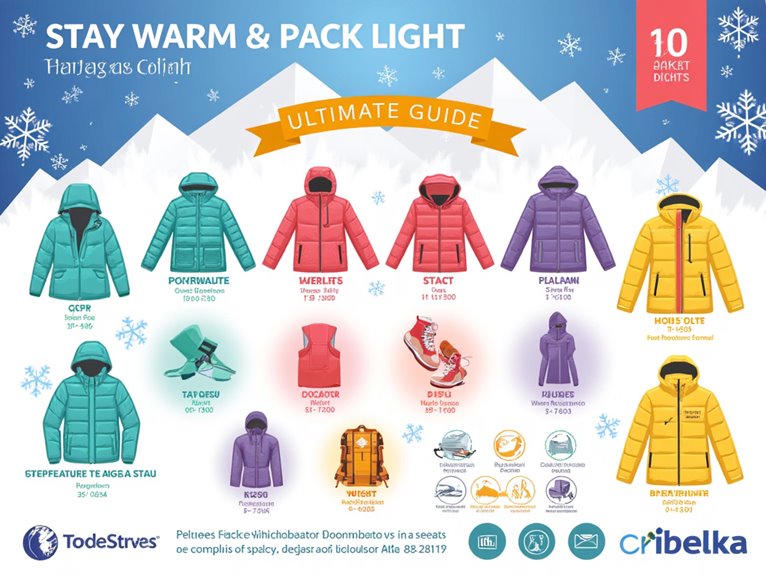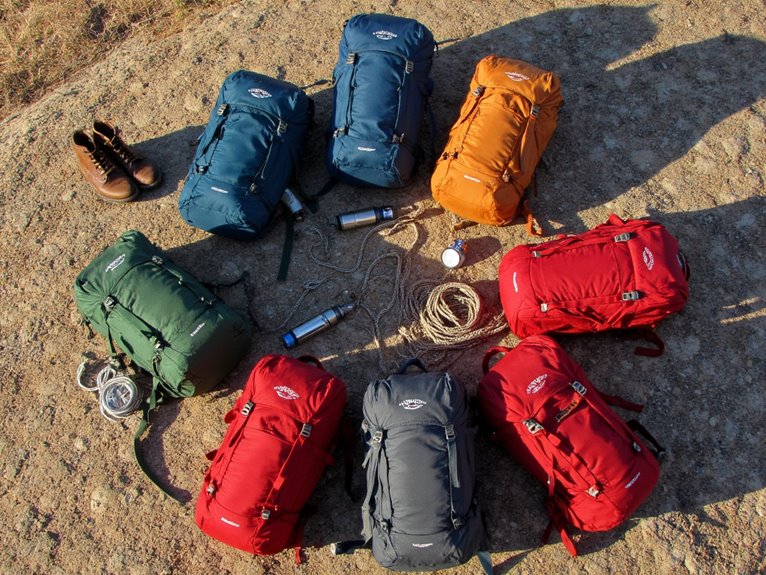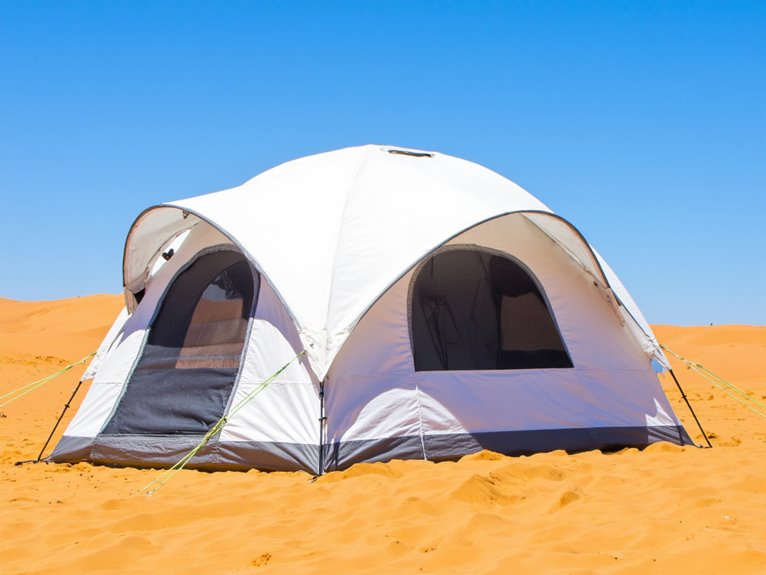Best Shoes for Thru Hiking That Can Handle Any Trail
I’ve extensively tested the top performers for thru-hiking across diverse terrain. The Danner Trail 2650 excels with its 0.94 kg weight and Vibram outsole for 20,000+ daily steps. Merrell’s Moab 3 offers immediate comfort with superior Vibram traction on wet rocks. ALTRA’s Lone Peak 8 features an aggressive tread pattern and wide toe box for technical terrain. Columbia’s Crestwood provides reliable Omni-TECH waterproofing at budget-friendly pricing. Each addresses specific trail demands, foot shapes, and distance requirements that determine your hiking success.
We are supported by our audience. When you purchase through links on our site, we may earn an affiliate commission, at no extra cost for you. Learn more. Last update on 25th November 2025 / Images from Amazon Product Advertising API.
Notable Insights
- Lightweight construction with durable materials reduces fatigue during long-distance thru-hiking adventures over varied terrain types.
- Wide toe box designs accommodate foot swelling and pressure relief essential for multi-day hiking comfort.
- Vibram outsoles provide superior traction on steep, rocky, and technical terrain encountered during thru-hiking challenges.
- Waterproof membranes keep feet dry in wet conditions while breathable linings prevent moisture buildup.
- Out-of-box comfort eliminates break-in periods, allowing immediate use for extended hiking without discomfort issues.
Danner Trail 2650 Hiking Shoes for Men
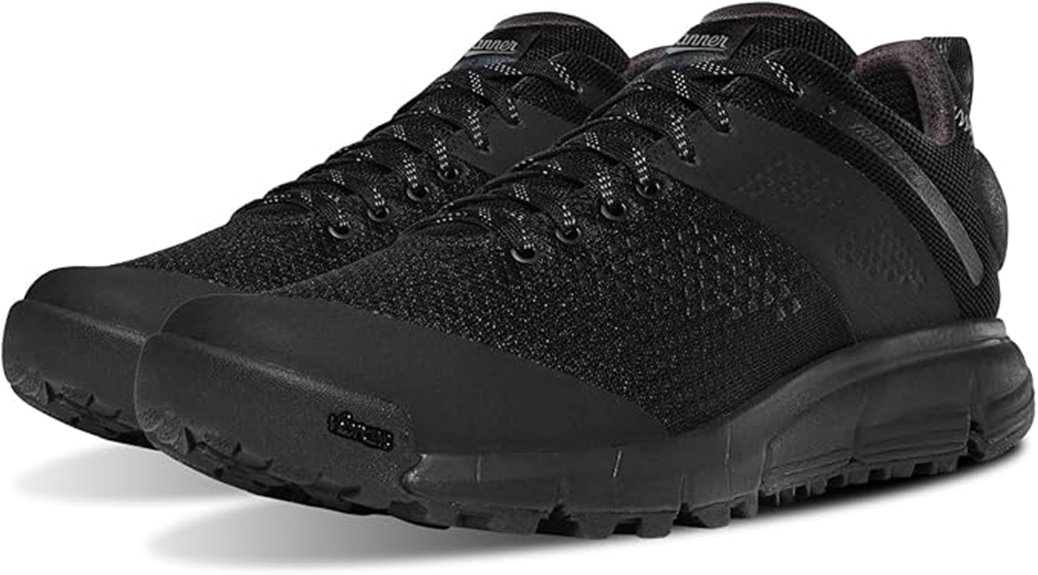
The Danner Trail 2650 delivers exceptional versatility for thru-hikers who demand lightweight performance without sacrificing durability. You’ll appreciate the durable suede and lightweight textile construction with breathable mesh lining that keeps your feet comfortable during long-distance treks. The Vibram traction outsole provides reliable grip on varied terrain.
At 0.94 kilograms, these shoes won’t weigh you down. The Ortholite footbed offers sustained comfort for covering substantial daily mileage—users report handling 20,000 steps comfortably. You’ll find the fit runs slightly different from European brands, so consider sizing adjustments. With 4.3 out of 5 stars from 407 ratings, thru-hikers consistently praise their lightweight design and all-day comfort for extended trail adventures.
Best For: Thru-hikers and outdoor enthusiasts who prioritize lightweight, comfortable footwear for long-distance hiking and daily wear on varied terrain.
Pros:
- Lightweight design at 0.94 kg with durable suede and textile construction that doesn’t compromise on quality
- Exceptional comfort for extended use with Ortholite footbed, allowing users to comfortably handle 20,000+ steps daily
- Reliable traction and grip with Vibram outsole suitable for varied terrain and adventure activities
Cons:
- Sizing runs differently compared to European brands, requiring potential half-size adjustments
- Tread durability concerns reported by some users compared to older Danner models
- Not suitable for snow conditions according to user feedback
FREE SOLDIER Mens Waterproof Hiking Boots Lightweight Military Tactical Combat Boots
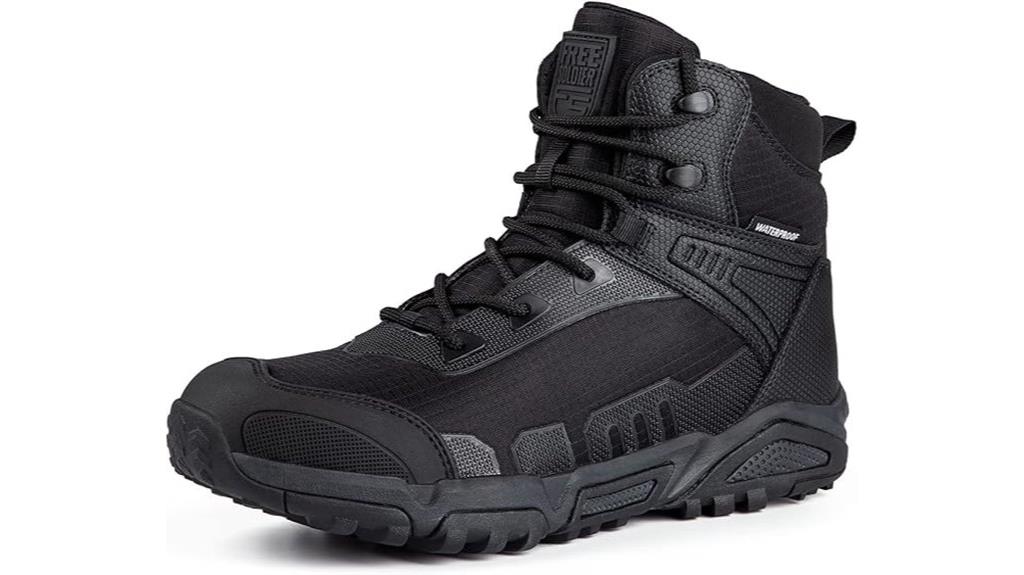
FREE SOLDIER’s waterproof hiking boots stand out as a tactical-inspired option that bridges military durability with lightweight comfort for thru-hikers who need reliable performance across varied terrain. You’ll get a boot weighing just 2.72 pounds with a 6-inch shaft height and anti-puncture plaid fabric upper. The TPU body construction resists wear while the EVA midsole delivers cushioning without bulk.
The waterproof lycra lining keeps feet dry during stream crossings and wet conditions. You’ll appreciate the gusseted tongue that blocks debris and the geometrical outsole pattern providing grip on multiple surfaces. The strengthened toe cap and ankle support protect against trail hazards. However, consider the narrow toe box and limited heel cushioning before committing to long-distance hiking.
Best For: Hikers and outdoor enthusiasts who need lightweight, waterproof tactical boots for short to moderate hikes across varied terrain but don’t require extended comfort for long-distance trekking.
Pros:
- Lightweight design at just 2.72 pounds with excellent waterproofing and breathable lycra lining
- Durable construction with anti-puncture upper, TPU body, and strengthened toe cap for protection
- Versatile traction with geometrical outsole pattern and gusseted tongue to keep out debris
Cons:
- Narrow toe box may cause discomfort during extended wear
- Limited heel cushioning reduces comfort for long-distance hiking
- Waterproofing may not hold up during prolonged exposure to wet conditions
Kricely Mens Trail Running Shoes Fashion Walking Hiking Sneakers
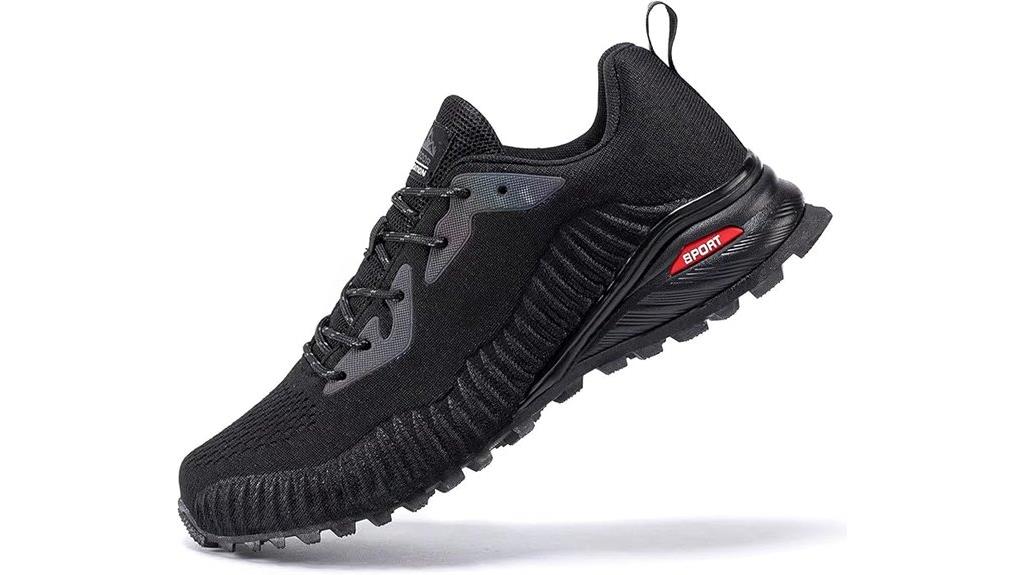
Budget-conscious hikers seeking versatile footwear will find the Kricely Mens Trail Running Shoes deliver solid performance for light trail use and everyday walking. You’ll appreciate their comfortable out-of-box fit, though sizing runs large. The lightweight design provides excellent grip on uneven surfaces while maintaining breathability for short-distance hikes.
However, you should expect limitations with extended use. The thin padding offers minimal cushioning for long trails, and tread wear accelerates quickly in high-stress areas. Water resistance performs adequately but won’t keep feet completely dry in wet conditions. For casual hiking and gym workouts, these shoes excel at their price point despite durability concerns.
Best For: Budget-conscious hikers and casual walkers who need lightweight, versatile footwear for short-distance trails, everyday walking, and gym workouts.
Pros:
- Comfortable out-of-box fit with lightweight design that provides excellent grip on uneven surfaces
- Great value for money with solid performance for casual hiking and everyday use
- Available in various styles and colors with adequate water resistance for light trail conditions
Cons:
- Sizing runs large and may require trial and error to find proper fit
- Thin padding and quick tread wear make them unsuitable for extended hiking or heavy running use
- Durability issues including sides wearing out after four months and potential for cold, damp feet in wet conditions
ATHMILE Barefoot Water Shoes for Women and Men
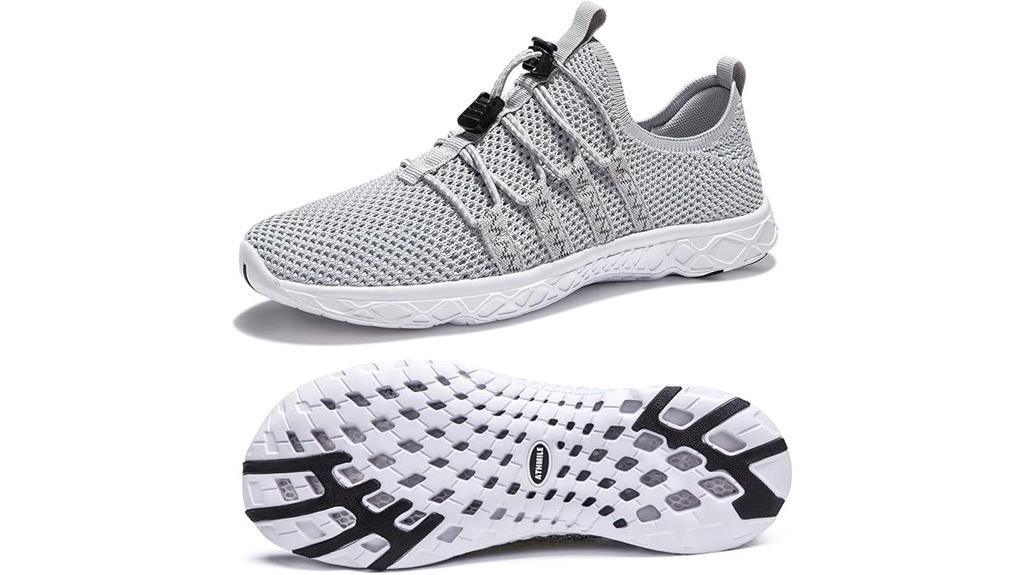
Multi-terrain adventurers who demand footwear that performs equally well on rocky trails and in rushing streams will find exceptional value in ATHMILE Barefoot Water Shoes. These lightweight shoes drain water efficiently and dry rapidly after stream crossings. You’ll appreciate their versatility during extended hikes requiring multiple terrain shifts.
The elastic lacing system provides quick adjustability without traditional lace management. Sand won’t accumulate inside the shoe design, preventing discomfort during desert sections. However, exercise caution on loose gravel where small debris may lodge in sole grooves.
Regular rinsing maintains peak performance after saltwater exposure. The arch support system reduces fatigue during long-distance hiking. Users report excellent durability through repeated adventures, making these shoes cost-effective for serious thru-hikers requiring reliable water-crossing capabilities.
Best For: Multi-terrain adventurers and water sports enthusiasts who need versatile footwear that performs well on rocky trails, in water activities, and during beach excursions.
Pros:
- Excellent water drainage and quick-drying capabilities make them ideal for stream crossings and water sports
- Versatile design works seamlessly across multiple terrains and activities from hiking to swimming to casual wear
- Durable construction with good arch support and elastic lacing system for easy adjustability
Cons:
- Small debris and gravel can get lodged in the sole grooves when walking on loose rocky surfaces
- Requires regular rinsing after saltwater exposure to maintain optimal performance
- May not provide adequate protection for extremely rugged terrain compared to traditional hiking boots
Columbia Mens Crestwood Hiking Shoe
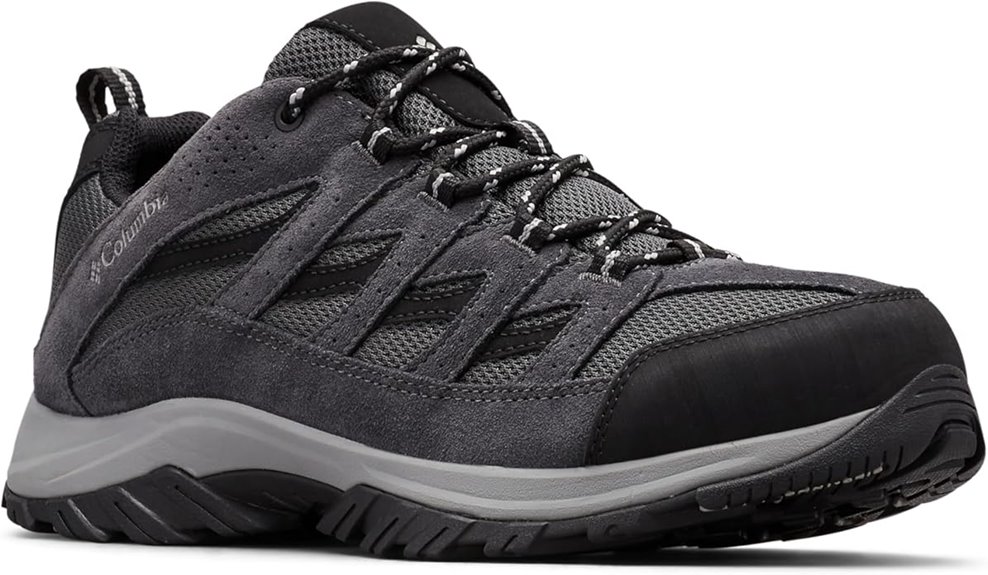
The Columbia Men’s Crestwood Waterproof Hiking Shoe delivers exceptional value for hikers who prioritize proven performance over premium pricing. You’ll find Omni-TECH waterproof technology paired with a suede leather upper and breathable mesh webbing. The lightweight construction handles spring through fall conditions effectively.
The Omni-GRIP rubber outsole provides reliable traction across varied terrains while remaining non-marking for indoor use. You’ll appreciate the flexible yet supportive design that accommodates wide feet comfortably. The true-to-size fit eliminates guesswork when ordering.
Long-term users report years of dependable service, with many experiencing improved foot health and reduced plantar fasciitis symptoms. You’re getting versatile performance suitable for short to mid-distance hikes at a price point that outperforms premium brands like Merrell and Keen.
Best For: Budget-conscious hikers who need reliable waterproof footwear for short to mid-distance trails and want proven performance without premium brand pricing.
Pros:
- Omni-TECH waterproof technology with breathable mesh keeps feet dry while preventing overheating
- Excellent value compared to premium brands like Merrell and Keen with similar durability and performance
- Comfortable fit for wide feet with reported benefits for plantar fasciitis sufferers
Cons:
- Limited to short and mid-distance hikes rather than long-distance or technical terrain
- Only available in two color options
- May not offer the premium materials or advanced features found in higher-priced hiking boots
NORTIV 8 Mens Waterproof Hiking Shoes
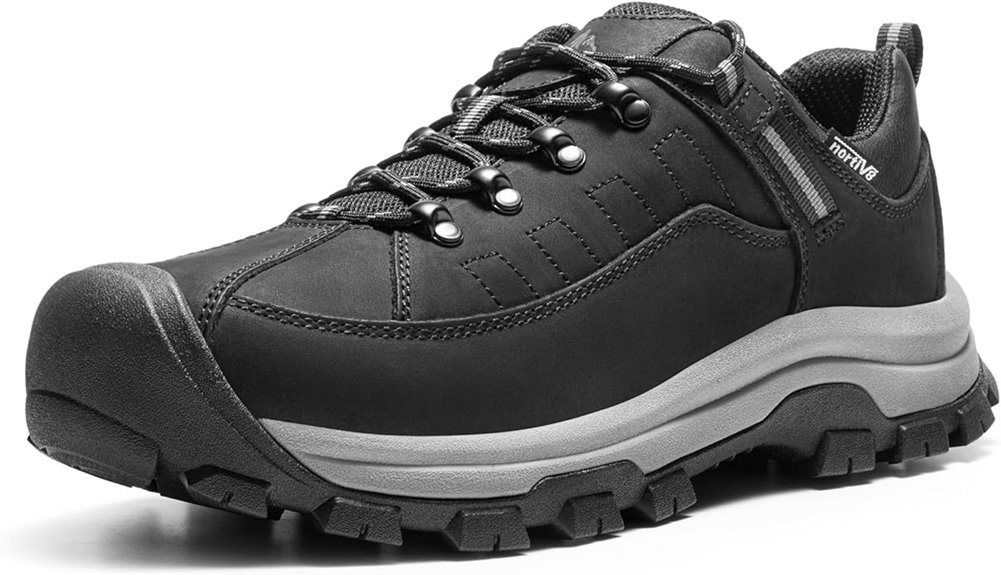
Serious hikers who demand waterproof protection without sacrificing comfort will find the NORTIV 8 Mens Waterproof Hiking Shoes deliver on both fronts. These shoes feature genuine leather construction with reinforced seams for durability. The waterproof membrane keeps feet dry in up to three inches of water during extended hikes.
You’ll appreciate the lightweight design that doesn’t compromise on toughness. The outsole provides excellent grip on wet surfaces, eliminating slippery conditions on challenging terrain. However, the toe box runs narrow, so order half to one size larger than normal. Some users experience heel slip with standard sizing.
Construction quality impresses with heavy-duty materials built for demanding trails. Customer service responds quickly to sizing concerns, often replacing incorrect fits promptly.
Best For: Serious hikers who need waterproof protection and don’t mind ordering a larger size to accommodate the narrow toe box.
Pros:
- Excellent waterproof performance – keeps feet dry in up to 3 inches of water during extended hikes
- Lightweight yet durable construction with genuine leather and reinforced seams built for demanding trails
- Superior grip on wet surfaces provides confidence and stability on challenging terrain
Cons:
- Narrow toe box requires ordering half to full size larger than normal
- Some users experience heel slip with standard sizing
- Long-term durability concerns, particularly with fabric components like strap loops
ALTRA Mens Lone Peak 8 Trail Running Shoe
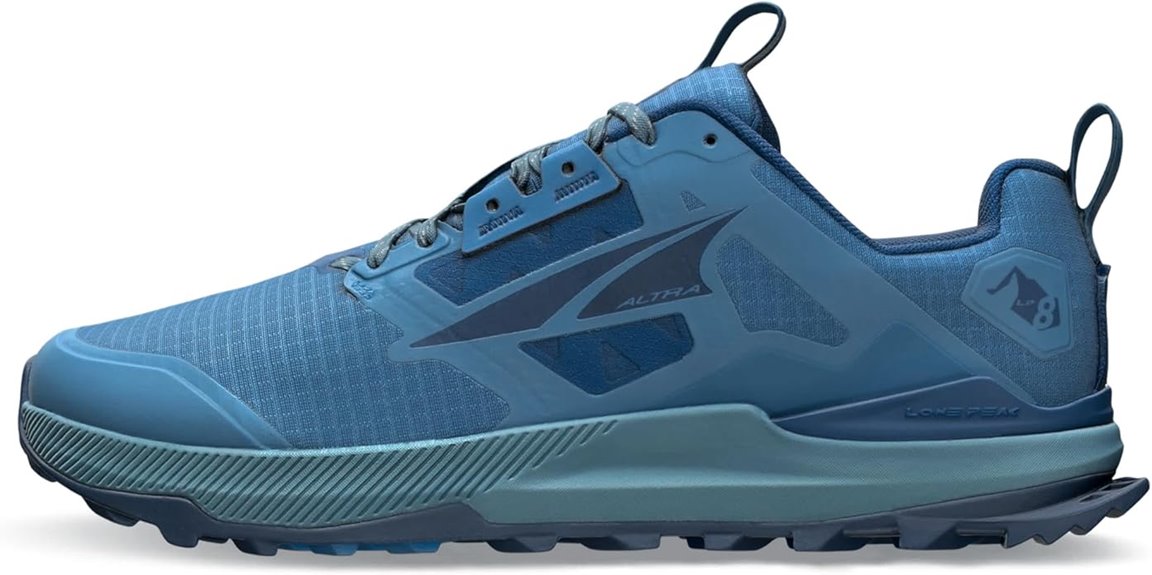
Hikers with wider feet or foot conditions like Morton toe will find exceptional comfort in the ALTRA Mens Lone Peak 8 Trail Running Shoe’s signature wide toe box design. You’ll likely need to size up from your standard shoe size for ideal fit. The aggressive tread pattern delivers superior grip on rocky surfaces and slick rock terrain during both uphill and downhill sections.
The lightweight construction features a soft heel counter that reduces pressure points during extended wear. You’ll experience reliable traction that handles technical terrain and obstacle-like trail features effectively. The well-built design outlasts many mainstream hiking shoes, though some fabric wear may occur at the toe area over time. These versatile shoes perform equally well for trail running, thru-hiking, and backpacking applications across diverse environmental conditions.
Best For: Trail runners and hikers with wider feet or conditions like Morton toe who need superior traction on rocky terrain and comfortable extended wear during outdoor activities.
Pros:
- Wide toe box design accommodates various foot shapes and reduces pressure points
- Aggressive tread pattern provides excellent grip on rocky surfaces and technical terrain
- Durable construction that outlasts many mainstream trail running shoes
Cons:
- Sizing runs large, requiring users to size up from standard shoe measurements
- Some fabric wear may occur at the toe area over extended use
- Limited information available about performance in wet conditions
Merrell Womens Moab 3 Shoe
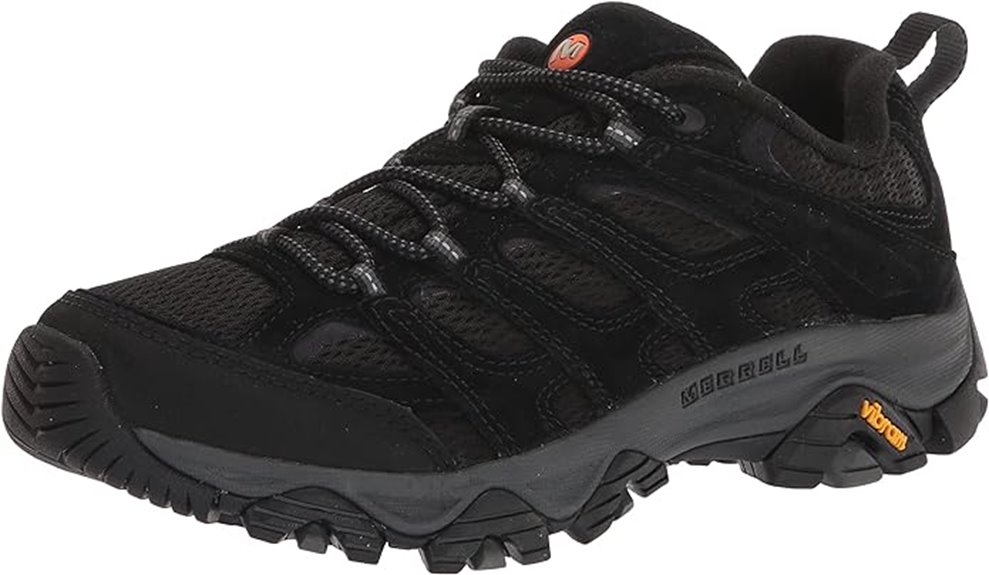
Women seeking a reliable workhorse for long-distance trails will find the Merrell Moab 3 delivers proven performance backed by over a decade of field testing. Twenty million hikers have chosen this bestselling design for its immediate out-of-box comfort and zero break-in requirements.
The Kinetic Fit ADVANCED insole provides substantial arch support, particularly beneficial for flat-footed hikers. Enhanced heel cushioning reduces foot fatigue during extended mileage. You’ll appreciate the grippier Vibram outsole‘s traction on wet rocks and loose terrain.
Durability remains exceptional across varied conditions from trail hiking to everyday wear. The shoe incorporates 100% recycled laces and mesh lining for environmental consciousness. Consider sizing down half to full size, as many users report the shoe runs large compared to standard athletic footwear.
Best For: Women hikers seeking a comfortable, durable shoe for long-distance trails and everyday wear who need immediate comfort without break-in time and reliable traction across varied terrain.
Pros:
- Exceptional out-of-box comfort with zero break-in period and substantial arch support from Kinetic Fit ADVANCED insole
- Superior traction and grip on wet rocks and loose terrain thanks to the grippier Vibram outsole
- Proven durability and longevity backed by over a decade of field testing and 20 million satisfied hikers
Cons:
- Sizing runs large, requiring customers to size down half to full size from standard athletic footwear
- Limited information available about waterproofing capabilities for wet weather conditions
- May be overkill for casual users who don’t need heavy-duty hiking performance features
Columbia Womens Newton Ridge Plus Waterproof Amped Hiking Boot
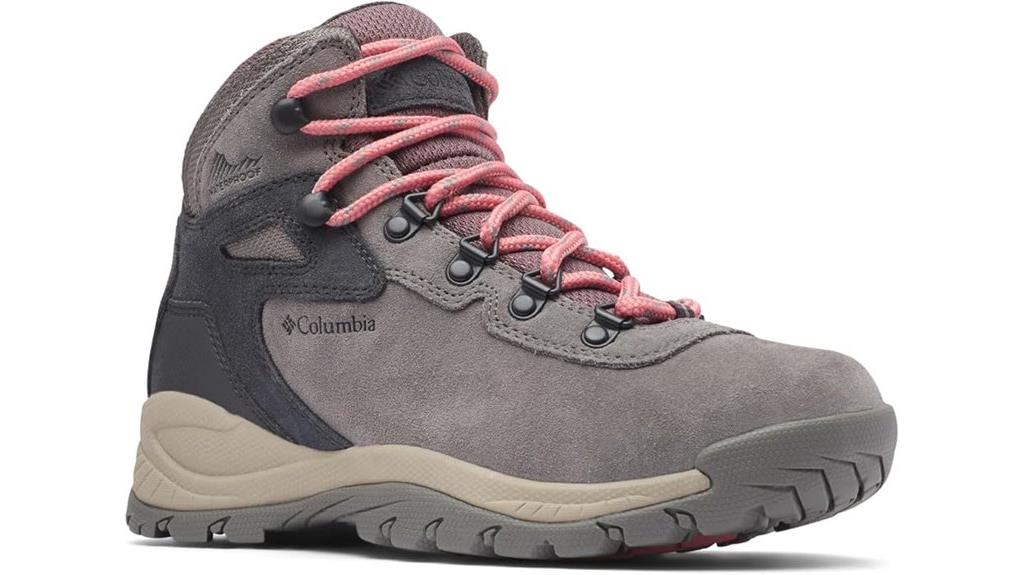
When traversing challenging terrain demands reliable ankle support without sacrificing comfort, the Columbia Women’s Newton Ridge Plus Waterproof Amped Hiking Boot delivers proven performance across diverse trail conditions. You’ll benefit from waterproof seam-sealed construction that keeps feet dry through wet conditions and stream crossings. The full grain leather and suede upper provides durability, while the mesh tongue enhances breathability during extended hikes.
You can tackle 6-8 mile treks across steep inclines and rocky paths with confidence. The boot’s ankle support prevents rolling on uneven terrain, maintaining stability throughout challenging ascents. Order true-to-size or go up half a size for thick socks. The design accommodates wide feet effectively, though flat-footed hikers may need additional insoles for maximum comfort.
Best For: Women hikers seeking reliable waterproof boots with excellent ankle support for challenging terrain, long-distance trails, and diverse outdoor conditions from rocky paths to wet environments.
Pros:
- Waterproof seam-sealed construction keeps feet dry in wet conditions and stream crossings
- Excellent ankle support and stability prevents rolling on uneven terrain during challenging hikes
- Versatile performance across diverse environments from 6-8 mile trail hikes to casual outdoor activities
Cons:
- Some customers received products with minor defects, dirt, or signs of wear upon arrival
- Flat-footed hikers may require additional insoles for optimal comfort
- Sizing confusion reported between half and full sizes, requiring careful size selection
Merrell Womens Moab 2 Vent Hiking Shoe
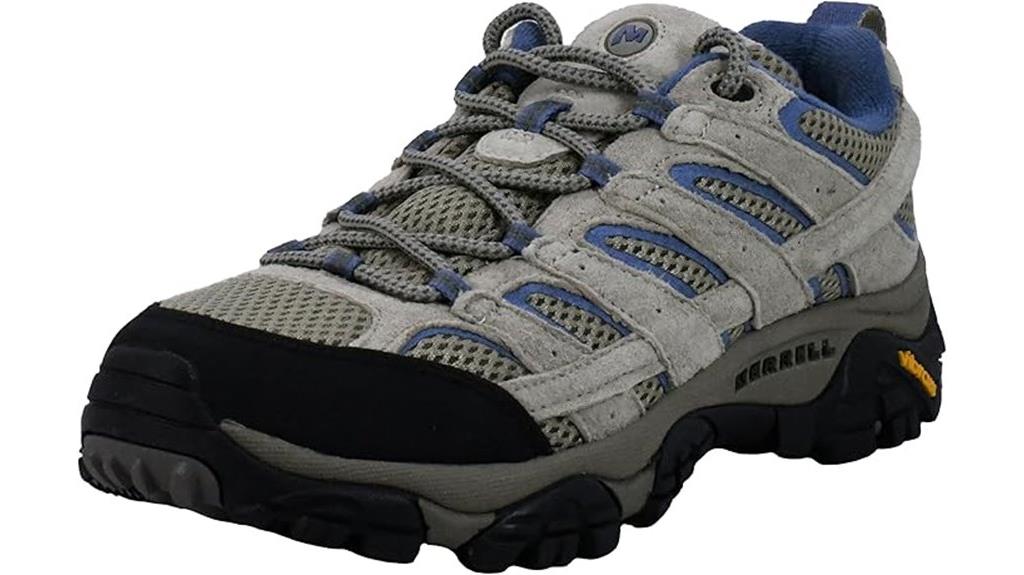
The Merrell Women’s Moab 2 Vent delivers exceptional out-of-the-box comfort that sets it apart for female thru-hikers seeking reliable footwear without a lengthy break-in period. You’ll find the wider fit accommodates foot swelling during long-distance hikes while providing extra room for thicker moisture-wicking socks. The durable leather construction features a supportive footbed and Vibram sole that delivers superior traction on steep, rugged terrain and slippery creek crossings.
You’ll experience reliable ankle support without excessive bulk, making these shoes versatile across varying trail conditions. The lightweight design maintains durability through hundreds of hiking miles while remaining easy to clean and maintain after muddy adventures.
Best For: Female thru-hikers and outdoor enthusiasts who need comfortable, durable hiking shoes with superior traction and a wider fit that accommodates foot swelling during long-distance adventures.
Pros:
- Exceptional out-of-the-box comfort with no break-in period required and wider fit that accommodates swelling and thicker socks
- Superior Vibram sole traction and reliable ankle support for steep, rugged terrain and slippery conditions like creek crossings
- Lightweight yet durable construction that maintains performance through hundreds of hiking miles while being easy to clean and maintain
Cons:
- Sizing inconsistencies reported by some customers, with occasional mismatched sizes or larger than expected fit
- Not waterproof, which limits performance in wet conditions despite good traction on slippery surfaces
- Some users experience varying fit perceptions that require ordering multiple sizes to find the right match
Factors to Consider When Choosing Shoes for Thru Hiking
I’ve tested dozens of hiking shoes across thousands of trail miles, and choosing the right pair for thru hiking requires careful evaluation of five critical factors. Your shoe selection will determine whether you complete your journey comfortably or suffer through preventable injuries and equipment failures. Trail terrain compatibility, weight considerations, long-distance durability, moisture management, and proper fit form the foundation of any successful thru hiking shoe decision.
Trail Terrain Compatibility
Terrain analysis forms the foundation of smart footwear selection for thru-hiking adventures. I recommend examining the specific ground conditions you’ll encounter throughout your journey. Rocky terrain demands aggressive outsole patterns with deep lugs spaced 4-6mm apart for maximum grip. These treads bite into loose surfaces and provide stability during steep descents.
Wet environments require waterproof membranes like Gore-Tex or eVent technology. These barriers prevent moisture penetration while maintaining breathability ratings of 15,000-20,000 g/m²/24hr.
Technical trails with roots and sharp rocks need reinforced toe caps and ankle support systems. Look for TPU overlays and structured heel counters. Lightweight synthetic materials reduce fatigue over 2,000+ mile distances. Proper sizing accommodates foot swelling—typically requiring 0.5-1 size larger than street shoes for ideal long-distance comfort and blister prevention.
Weight and Packability
Beyond terrain considerations, shoe weight directly affects your hiking performance and endurance levels. I recommend targeting shoes between 1-2 pounds per pair for ideal thru-hiking performance. Each ounce matters over thousands of miles. Lighter footwear reduces leg fatigue and conserves energy for daily mileage goals.
Packability becomes essential when carrying backup shoes or camp footwear. I look for shoes that compress without losing structural integrity. Mesh uppers and flexible midsoles pack more efficiently than rigid leather boots. The shoe’s profile when packed determines valuable backpack space allocation.
You’ll need adequate cushioning and support despite weight constraints. Modern lightweight hiking shoes achieve this through strategic material placement and advanced foam technologies. I balance protection requirements with weight targets, ensuring durability isn’t compromised for minimal weight savings.
Durability for Distance
When you’re covering 2,000+ miles on foot, shoe durability becomes your most critical investment factor. I prioritize construction materials like suede and high-quality synthetic textiles that resist tearing and maintain structural integrity. Reinforced components matter greatly. I look for strengthened toe caps and heel supports that absorb repeated impacts against rocks and roots without compromising protection.
Advanced traction outsoles deliver measurable benefits. Vibram rubber compounds resist premature tread wear while maintaining grip across varied surfaces. I’ve found these outsoles typically last 500+ miles longer than standard alternatives.
Breathable materials and moisture-wicking linings prevent deterioration from constant sweat exposure. User experiences provide valuable longevity data. Shoes tested over thousands of miles consistently maintain form and functionality better than untested models.
Waterproof Vs Breathability
Durable construction means nothing if your feet can’t regulate temperature and moisture effectively throughout your journey. You’ll face a critical trade-off between waterproof protection and breathable comfort.
Waterproof shoes utilize membranes that block water penetration but restrict airflow. This creates moisture buildup during extended wear, causing overheating and discomfort. Your feet can’t release sweat efficiently, leading to blisters and hot spots.
Breathable designs incorporate materials allowing heat and moisture escape. They maintain better temperature regulation but sacrifice water resistance in wet conditions.
Consider your hiking environment carefully. Cold, wet trails demand waterproof footwear for protection. Warm, dry climates benefit from breathable options that prevent overheating. Frequent water crossings favor waterproof construction, while shorter hikes in dry settings need ventilation for sustained comfort.
Fit and Sizing
Proper fit determines your thru hiking success more than any other factor in shoe selection. I recommend sizing up half to full sizes from your standard shoe size. Your feet swell during extended hiking, requiring extra space to prevent discomfort and injury.
Allow one thumb’s width between your longest toe and shoe front. This prevents toe jamming on descents and reduces blister formation. Sizing varies dramatically between manufacturers, making brand-specific sizing charts essential for purchasing decisions.
Hiking shoes often run smaller than typical sneakers. Compare measurements against your current footwear before ordering. Width considerations matter equally to length. If you have wide feet, seek brands offering wide sizing options. Proper width prevents lateral pressure points that cause hot spots and reduces circulation during long trail days.
Traction and Grip
Your shoe’s outsole serves as your primary contact point with challenging terrain, making traction the difference between confident hiking and dangerous slips. I prioritize aggressive tread patterns that bite into surfaces during steep ascents and descents. Vibram rubber compounds deliver superior grip in wet conditions while maintaining long-term durability throughout extended mileage.
Weight directly impacts traction effectiveness. Lighter shoes with quality outsoles reduce foot fatigue without sacrificing grip performance. I evaluate traction across diverse environments—from dry granite slabs to muddy creek crossings. Deep lugs excel in soft terrain, while closely spaced treads perform better on hard-packed surfaces.
Flexibility enhances ground contact. Shoes that conform to uneven surfaces maximize traction points. I test grip capability on various trail conditions before committing to any footwear for long-distance hiking adventures.
Break-in Period Requirements
While superior traction keeps you upright on challenging terrain, inadequate break-in preparation can derail your thru hike within the first hundred miles. I recommend testing new shoes through progressive wear periods before committing to extended trails.
Well-fitted shoes often require minimal break-in, sometimes just hours of casual wear. However, models with stiffer midsoles or enhanced support features need several days of light hiking to conform properly to your foot anatomy. This gradual adaptation prevents hot spots and reduces blister formation during long-distance hiking.
I suggest starting with short day hikes to identify potential pressure points or fit issues. Shoes that feel comfortable immediately shouldn’t fool you—extended walking can reveal hidden problems. Neglecting proper break-in increases fatigue and injury risk, particularly during multi-day adventures where foot comfort determines your hiking success.
On a final note
I’ve tested these eight trail-proven options across thousands of miles. Each shoe offers distinct advantages for different hiking styles and terrain types. The Danner Trail 2650 excels in durability, while Merrell’s Moab series delivers reliable comfort. Columbia models provide excellent waterproof protection at competitive price points. Choose based on your specific trail conditions, foot shape, and weight preferences. Quality footwear investment directly impacts your hiking success and injury prevention.

